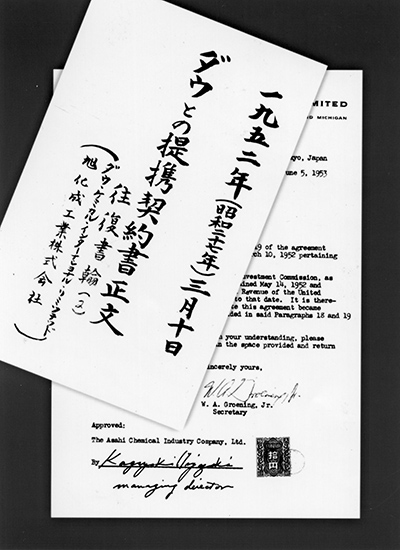In the summer of 1950, I went to the United States as a member of the first postwar mission there. My main purpose was to study American labor issues and I spent about a month visiting major cities like New York, Chicago, and San Francisco.
I had one other objective for this trip to the US. It was to license technology to manufacture Saran™ polyvinylidene chloride fiber from the Dow Chemical Company.
Asahi Kasei had been researching this kind of fiber as a way to effectively use the chlorine that is produced when making caustic soda. We even built a pilot plant in 1949, but couldn’t achieve satisfactory results for commercialization. It was then that we heard the news that the Dow Chemical Company had successfully developed a new synthetic fiber made using chlorine.
After I finished the mission itinerary, Yoshi Tsunoda (who later became President of Asahi-Dow), chief of the Research Department, and Manabu Enseki (currently Managing Director at Asahi-Chiba Limited), chief of the Foreign Trade Department, joined me to visit the company’s main office in Midland, Michigan.
As expected, it wasn’t easy to negotiate a technology license. The Dow Chemical Company was known for being conservative, and they were reluctant to provide foreign companies with technology. Not only that, but Kureha Chemical Industry Co., Ltd. also wanted to commercialize Saran and had approached Dow Chemical around the same time.
It became a competition between us and Kureha. We explained to Dow Chemical the results of our research and experiments, earnestly appealing that we really needed their technology. In the spring of 1951, a representative of Dow Chemical visited Japan to assess the situation, and in the end they chose to go with Asahi Kasei.
I went to Midland again with Mr. Tsunoda and Mr. Enseki, and since I was still a Managing Director, I carried an authorization from the President and a certificate from the Consul of the United States in Kobe.
But the executive there told me, “We trust you Mr. Miyazaki, so just your signature will suffice.” This was unexpected, but I was pleased to know that I had gained their trust during the course of our difficult negotiations.
In July 1952, Asahi-Dow Co., Ltd. was launched as a 50-50 joint venture between Asahi Kasei and the Dow Chemical subsidiary Dow Chemical International Ltd.
However, the launch of Asahi-Dow came with unexpected difficulties. Saran is resistant to water and chemical agents, but it has drawbacks as an apparel fiber in terms of dyeability and texture.
In the company’s first three years of operation, the cumulative net loss reached 720 million yen. Today, that would be something like 10 billion yen. We promised Dow Chemical that they wouldn’t be asked to add capital, so this deficit was completely covered by Asahi Kasei. Some of our executives began to criticize me.
I later found out that Dow Chemical had considered closing the business down, but decided to keep it going because Asahi Kasei was covering the deficit.
Saran became steadily profitable when we advanced into film for wrapping food products such as ham and sausage. First we sold it for commercial use in January 1960, and then we started selling to consumers under the name Saran Wrap™. Demand subsequently exploded with the arrival of frozen and instant foods as well as the spread of electric refrigerators, finally putting us on track.
 Going to the United States to negotiate the
Going to the United States to negotiate the
establishment of Asahi-Dow (center)
We also decided to import the technology for STYRON™ polystyrene, and production started in February 1958. It is lightweight, freely colorable, and easily mass produced, and was profitable from the outset thanks to booming sales of electric appliances and automobiles.
We were also greatly supported by an annual 3.6% low-interest loan from Dow Chemical. Because Asahi Kasei covered all the losses from Saran, we gained their trust and they gave us their full-fledged cooperation.
We subsequently expanded into TYRIL™ acrylonitrile-styrene copolymer and STYLAC™ acrylonitrile-butadiene-styrene resin, and Asahi-Dow grew to become a top manufacturer of styrenic resins. The biggest significance of the creation of Asahi-Dow was that it built the foundation for the Asahi Kasei Group to enter the field of petrochemicals.
 Business alliance agreement with Dow Chemical
Business alliance agreement with Dow Chemical
International Ltd., 10 March 1952

